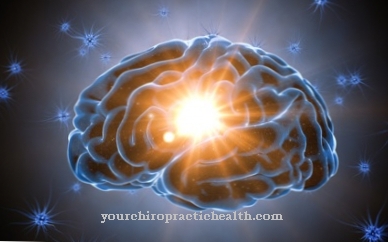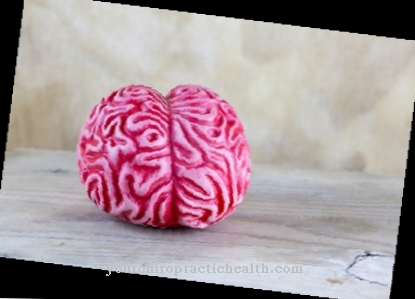In the Osteolysis it is the process of bone loss. This usually takes place within the framework of normal metabolism. However, if the balance between bone loss and bone formation is disturbed, pathological loss of bone substance can occur.
What is osteolysis?

Osteolysis is the scientific name for Bone loss, which is a normal and necessary process in bone metabolism. During this process, bones are constantly being rebuilt by breaking down existing bone substance and building it up elsewhere. The bone metabolism is regulated hormonally.
There are two types of cells in bone. On the one hand there are the osteoblasts and on the other hand the osteoclasts. The osteoblasts are responsible for building bones. After mineralization, they transform into osteocytes (bone cells) that are no longer able to divide.
The osteoclasts in turn control bone breakdown. These are multinucleated cells that have been transformed into macrophage-like cells through the amalgamation of stem cells from the bone marrow. Their job is, as so-called phagocytes, to dissolve the bone substance. There are two forms of osteolysis. This is on the one hand osteolysis as part of bone remodeling and on the other hand circumscribed osteolysis.
Bone remodeling is a general process in which there is a balance between bone loss and bone formation. With circumscribed osteolysis, local bone loss occurs, but this is pathological.
Function & task
Osteolysis is a necessary process in the organism that fulfills various functions at the same time. In the course of bone remodeling, bone substance must constantly be broken down and rebuilt elsewhere. This is called bone tissue remodeling.
The bone and skeletal system is the largest supporting organ in the body. The constant use of this support system leads to structural damage within the bones, which must be compensated at any time in order to keep the musculoskeletal system functional. This only works through the constant breakdown of damaged bone and the build-up of new bone substance.
In addition, this process also keeps the calcium and phosphate levels constant at the same time. The skeletal system is the largest calcium and phosphate reservoir.
If, for example, too little calcium is supplied through food, there is increased bone loss. Fluctuating calcium and phosphate levels can be quickly compensated for.
Overall, the bone and calcium metabolism is subject to hormonal regulation. The parathyroid hormone ensures a constant level of calcium in the blood by inducing increased bone loss by stimulating the osteoclasts. At the same time, when the calcium level in the blood is too high, it also affects the osteoblasts, which are responsible for building bones.
In a healthy, adult person who is still able to reproduce, bone loss and bone formation are in balance. This constant bone remodeling process ensures a healthy musculoskeletal system.
Illnesses & ailments
If the balance between osteolysis and osteogenesis (bone structure, also called ossification) is disturbed, damage to the bone structure occurs. In these disorders, the relationship between bone loss and bone formation is usually shifted in favor of bone loss. In very rare cases, however, the reverse relationship also occurs, with bone formation outweighing bone loss. This is the case, for example, with the genetic osteopetrosis (marble bone disease).
The more common cases of general bone loss are due to various causes. The balance can shift, among other things, due to the reduced activity of the osteoblasts, which disrupts the bone building process. However, due to the normal process of osteolysis, there is now general bone loss.
Furthermore, osteolysis can be intensified in rheumatic processes, hormonal disorders (hyperparathyroidism), osteoporosis or metastases on the bone. General osteoporosis also always occurs in old age. Here, bone formation slows down, while at the same time, often due to a lack of minerals as a result of absorption disorders, bone breakdown is accelerated. Hormonal causes of osteoporosis are often found in postmenopausal women.
In addition to osteoporosis, osteomalacia can also occur. While in osteoporosis the entire bone substance, which is composed of organic and mineral components, is broken down, in osteomalacia only the mineral component is lost. Often the cause is insufficient calcium incorporation in the bones, a lack of vitamin D or a disturbed phosphate metabolism.
In addition to the disturbance of the balance between bone formation and bone loss in the context of general bone remodeling, there is also the circumscribed osteolysis. The circumscribed osteolysis is always pathological and describes the local bone degradation caused by a local osteoclast overactivity without the osteoblast activity being increased. This means that it is a question of the local breakdown of bone substance, which, however, is no longer reproduced. A circumscribed osteolysis occurs, among other things, in inflammatory processes, local tumors or metastases on the bone in the case of foreign tumors or constant foreign body contact of the bone. For example, implants, endoprostheses or osteosynthesis (operative connection of several bones) can lead to osteolysis, so that the prosthesis can eventually loosen. The same applies to dental implants, which can lead to the destruction of the jawbone if there is constant external contact.
As a result of rheumatoid arthritis, bone cysts can appear near the affected joints. These bone cysts are already cavities that have been created by osteolysis. Localized proliferation of the bone marrow caused by a bacterial infection can also lead to osteolysis.
A very rare disease is the so-called Gorham-Stout Syndrome. Here a bone dissolves completely, which is then transformed into lymph tissue. The cause of this disease is currently unknown.








.jpg)



















